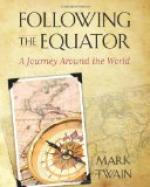A change had come, but that was political, and not visible from the ship. The monarchy of my day was gone, and a republic was sitting in its seat. It was not a material change. The old imitation pomps, the fuss and feathers, have departed, and the royal trademark—that is about all that one could miss, I suppose. That imitation monarchy, was grotesque enough, in my time; if it had held on another thirty years it would have been a monarchy without subjects of the king’s race.
We had a sunset of a very fine sort. The vast plain of the sea was marked off in bands of sharply-contrasted colors: great stretches of dark blue, others of purple, others of polished bronze; the billowy mountains showed all sorts of dainty browns and greens, blues and purples and blacks, and the rounded velvety backs of certain of them made one want to stroke them, as one would the sleek back of a cat. The long, sloping promontory projecting into the sea at the west turned dim and leaden and spectral, then became suffused with pink—dissolved itself in a pink dream, so to speak, it seemed so airy and unreal. Presently the cloud-rack was flooded with fiery splendors, and these were copied on the surface of the sea, and it made one drunk with delight to look upon it.
From talks with certain of our passengers whose home was Honolulu, and from a sketch by Mrs. Mary H. Krout, I was able to perceive what the Honolulu of to-day is, as compared with the Honolulu of my time. In my time it was a beautiful little town, made up of snow-white wooden cottages deliciously smothered in tropical vines and flowers and trees and shrubs; and its coral roads and streets were hard and smooth, and as white as the houses. The outside aspects of the place suggested the presence of a modest and comfortable prosperity—a general prosperity —perhaps one might strengthen the term and say universal. There were no fine houses, no fine furniture. There were no decorations. Tallow candles furnished the light for the bedrooms, a whale-oil lamp furnished it for the parlor. Native matting served as carpeting. In the parlor one would find two or three lithographs on the walls—portraits as a rule: Kamehameha IV., Louis Kossuth, Jenny Lind; and may be an engraving or two: Rebecca at the Well, Moses smiting the rock, Joseph’s servants finding the cup in Benjamin’s sack. There would be a center table, with books of a tranquil sort on it: The Whole Duty of Man, Baxter’s Saints’ Rest, Fox’s Martyrs, Tupper’s Proverbial Philosophy, bound copies of The Missionary Herald and of Father Damon’s Seaman’s Friend. A melodeon; a music stand, with ‘Willie, We have Missed You’, ‘Star of the Evening’, ‘Roll on Silver Moon’, ‘Are We Most There’, ‘I Would not Live Alway’, and other songs of love and sentiment, together with an assortment of hymns. A what-not with semi-globular glass paperweights, enclosing miniature pictures of ships, New England rural snowstorms, and the like; sea-shells with Bible texts carved on them in cameo style; native curios; whale’s tooth with full-rigged ship carved on it. There was nothing reminiscent of foreign parts, for nobody had been abroad. Trips were made to San Francisco, but that could not be called going abroad. Comprehensively speaking, nobody traveled.




